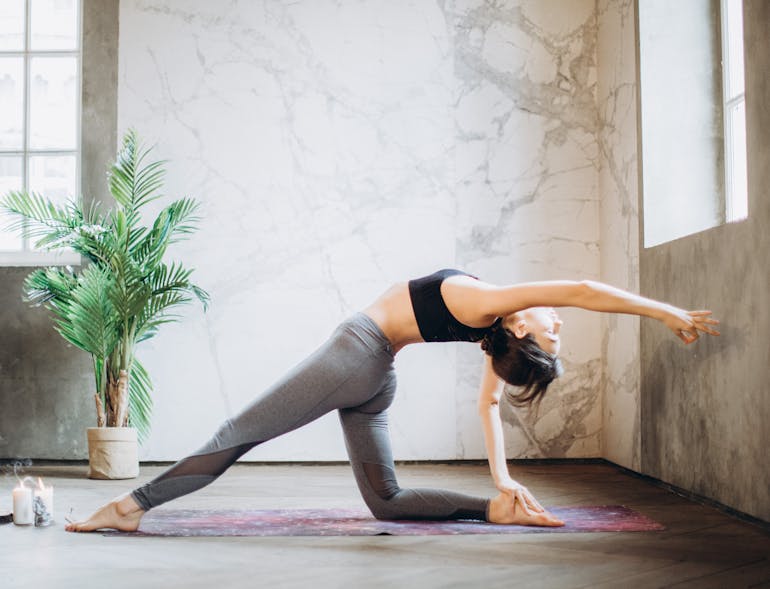
Burnout leaves the body feeling tense, drained, and distant. It can be hard to trust movement again after deep exhaustion. Gentle/restorative yoga offers a soft, healing path back to strength and calm. By moving slowly and breathing deeply, you can safely reconnect with your body after burnout. Small steps taken daily can rebuild energy, awareness, and peace. Here, we’ll guide you through simple, supportive practices. Small steps taken daily can rebuild energy, awareness, and peace. You do not have to push hard to feel better. Kindness and patience lead the way. So, let’s explore how gentle yoga can help you feel at home in your body once more.
Understanding Burnout and Its Impact on the Body
Burnout does more than make you feel tired. It affects your body deeply, draining energy, weakening muscles, and dulling your senses. Many people stop noticing how tense or stiff they have become. Over time, burnout creates a wall between your mind and body. Stress hormones stay high, causing tightness, headaches, and poor sleep.
Healing begins by paying attention to these signs. It is important to notice where you hold tension and where you feel weak. Awareness is the first step toward change. Gentle movement and mindful breathing can start to repair the damage. Recovery from burnout is slow, but every small step helps rebuild strength and trust.

Why Gentle/ Restorative Yoga Is Different from Other Exercise
Gentle/restorative yoga is different because it focuses on full relaxation, not effort or speed. In these practices, movements are slow, soft, and deeply supported by props. Each pose is designed to reduce tension and allow the body to fully rest. Instead of building sweat or strain, you focus on breathing, letting go, and feeling safe.
Many people find that it also supports better sleep and mental clarity through deep relaxation. Restorative yoga welcomes you to move at your own pace without pressure. This style of yoga is especially helpful for those recovering from deep fatigue or emotional stress. It gently restores balance, steadies emotions, and invites peace back into both body and mind.
When to Start Your Yoga Journey After Burnout
The best time to start gentle yoga is when movement feels inviting, not overwhelming. If getting out of bed feels too hard, begin with simple breathing exercises. If walking feels safe but tiring, gentle stretches might be your starting point. Some people return to yoga after a stressful job change, while others need it after caregiving or illness.
If you have just moved to a new home, it is wise to be careful when starting fresh, especially after a long-distance move. Fatigue and stress can linger longer than expected. Begin slowly with short sessions. Even five minutes of breathwork or a supported pose can be the first steps after a long distance move to help you reconnect safely.
How Gentle/Restorative Yoga Helps You Reconnect with Your Body After Burnout
Gentle/restorative yoga brings you back to yourself through slow, careful movement. Deep breathing resets your nervous system and calms racing thoughts. Supported poses help you notice where your body holds tension and where it feels open. Mindful stretching rebuilds trust between your body and mind, one breath at a time.
Many people also find that it brings powerful stress relief and relaxation during the healing process. This kind of practice teaches you to listen again, to rest without guilt, and to move without fear. By choosing calm, steady movements, you can heal the disconnect that burnout created.

Key Poses to Support Recovery and Relaxation
Certain poses work best when you need deep rest and healing. In gentle/restorative yoga, these poses are held for longer periods, giving your body time to release tension. Props like blankets, bolsters, and blocks make each position safe and supportive.
Some of the most helpful poses include:
● Child’s Pose – grounds you and calms the mind.
● Legs-Up-the-Wall Pose – reduces swelling and eases tired legs.
● Supported Bridge Pose – gently strengthens the back while opening the chest.
● Reclining Bound Angle Pose – relaxes hips and promotes deep breathing.
Creating a Soothing Yoga Space at Home
A calming space makes it easier to practice regularly. Choose a quiet area with little noise or
distraction. Use soft lighting to create a peaceful mood. Some people enjoy adding calming
music or nature sounds during their sessions. Keep your props, such as blankets, blocks, and
bolsters, close by for easy use.
Practicing gentle/restorative yoga at home gives you full control over your environment, which supports healing even more. Make your space simple, clean, and welcoming. A clear floor area with enough room to stretch is all you really need. When your surroundings feel safe and soothing, it becomes easier to relax fully.
How Consistency Gently Restores Energy Over Time
Healing takes time, but steady effort brings real change. Short, daily yoga sessions rebuild your strength without draining you. It is better to practice a little every day than push too hard once a week. You can also weave gentle breathing or stretching into a simple morning routine to start your day calmly. Over time, small habits grow into major shifts in how you feel.
Consistency teaches your body and mind that you are safe again. Even 10 minutes a day can improve sleep, ease muscle tension, and lift your mood. Trust that tiny steps are enough. Regular practice restores energy, builds patience, and brings a deep, lasting sense of balance.

Tips to Stay Kind and Patient with Yourself
Healing after burnout demands patience and self-compassion. Progress may feel slow, but every small step matters. It is important to accept that some days will be easier than others. Celebrate small wins, such as completing a short session or feeling calmer after breathing exercises. Rest when you need to without guilt or frustration.
Remember that gentle/restorative yoga teaches you to listen and respond kindly to your needs. Let each practice be a moment of care, not a task to complete. Stay connected to your body’s signals and honor them.
Find Strength and Peace Within
Healing takes time, but with steady care, recovery becomes possible. Through gentle/restorative yoga, you can slowly reconnect with your body after burnout. Each breath and movement brings you closer to feeling whole again. Trust the process, stay patient, and know that every moment of stillness supports your return to balance and strength.
Author Bio
Anna Fletcher is a wellness writer passionate about mindful movement, gentle healing, and
self-care. She believes slow, steady practices create lasting change and help people reconnect
with their bodies after burnout.
